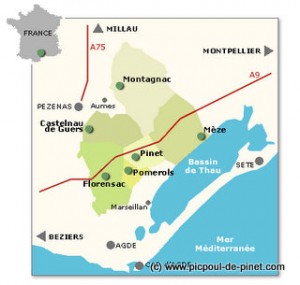Picpoul de Pinet
A version of this first appeared in Hampshire View, April 2010.
Picpoul de Pinet is one of those French wine appellations, and grape varieties, once discovered, long-loved. For a grape variety grown in the warm, sunny Mediterranean, inland from Sète, it has remarkable freshness and citrus-vivacity. Indeed, anyone in doubt of this grape’s freshness should look to its Occitan origins for a translation … lip stinger… so-called for the grape’s high natural acid content, which it retains well in the Mediterranean warmth. This may be partly due to the sea breezes cooling the extreme warmth of the day, and bringing much needed moisture to the vines on their panoramic limestone plateau.

Picpoul de Pinet
It has other quirky attributes too. It is a white-wine-only cru of the Coteaux du Languedoc appellation, though Picpoul de Pinet is always prominently displayed on the label, so it’s easy to find. The region is well on its way to achieving its own stand-alone appellation, AoC Picpoul de Pinet.
There is only one other white Languedoc AoC (the much less well known Clairette du Languedoc). Such rarity value in the sprawling, delightful Languedoc, better known for its reds from grenache, syrah, carignan et al., makes it something of a minor gem.
It’s also one of those rare things in France, varietally-labelled wine. Alsace is normally regarded as France’s mainstay of varietal labelling. Even more than this, picpoul de pinet has its own special, slender bottle, with an embossed Languedoc cross, for further ease of recognition. In other words, it’s difficult to miss (once you know what you’re looking for).
Picpoul is also becoming the trendy wine to be seen drinking. This resurgence is much overdue as its earlier spotlight was in the late 19th century under Napoléon III.
The appellation covers a mere 1,300 hectares, and lies between Pezenas and Mèze, overlooking the salt water lagoon of the Bassin de Thau, where oysters and mussels are farmed. And it is as an aperitif and to accompany such seafood that it reaches its simple apogee.
For this reason, it’s sometimes called it the ‘muscadet of the Languedoc’, though the flavour profile is fuller, if similarly zesty. Picpoul tastes best in the prime of its youth, when it is showing full flavours to their best: white flower blossom, lemon freshness, soft green apple, richly flavoured and relatively full bodied, with just a hint of herbal complexity to the finish of the better examples. It’s a wine that wisely doesn’t see any overt oak influence. Massively complex it will never be, but as a good flavoursome drop with a bite of freshness, it excels.
Here’s a few to try:
Domaine de Creyssels, Picpoul de Pinet, Coteaux du Languedoc, 2009, £7.70, Stone, Vine and Sun
Domaine de Belle Mare, Picpoul de Pinet, Coteaux du Languedoc 2009 £7.70, Great Western Wine
Els Pyreneus, La Cote Flamenc Picpoul de Pinet, Coteaux du Languedoc 2009 £8.06, Nebuchadnezzar Wines
Domaine Félines-Jourdan, Picpoul de Pinet, Coteaux du Languedoc, 2009 £7.50, The Wine Society



